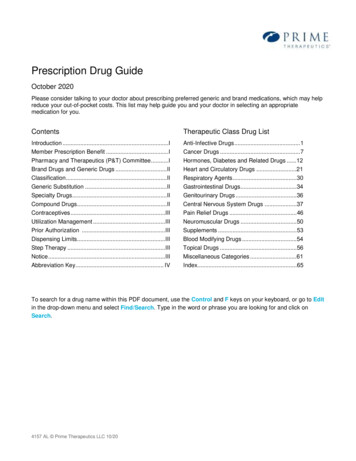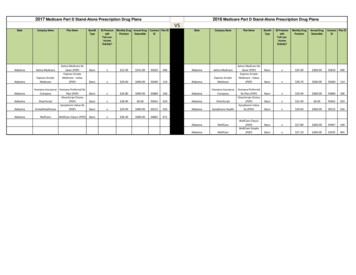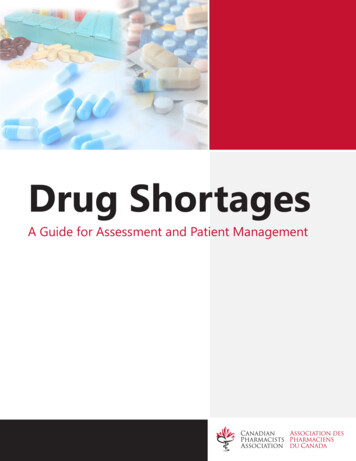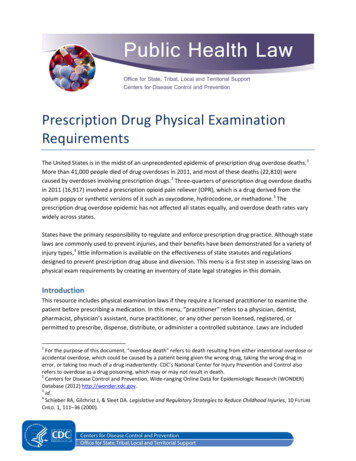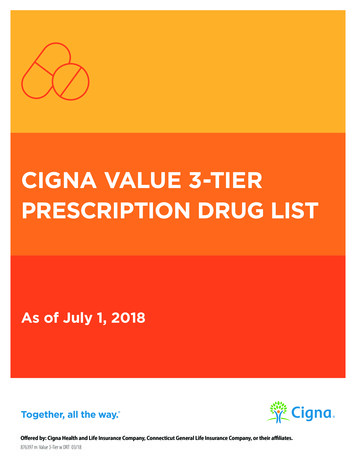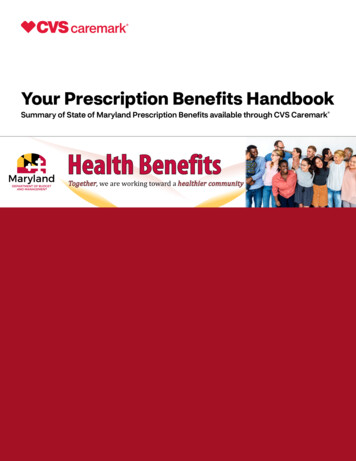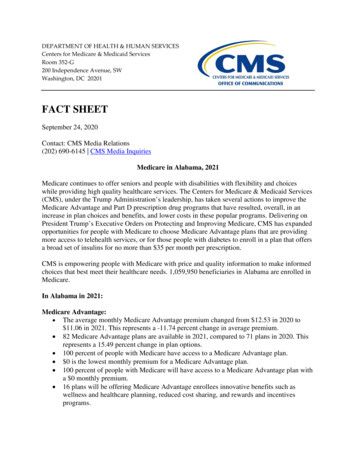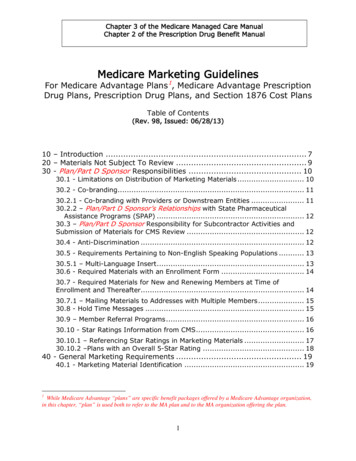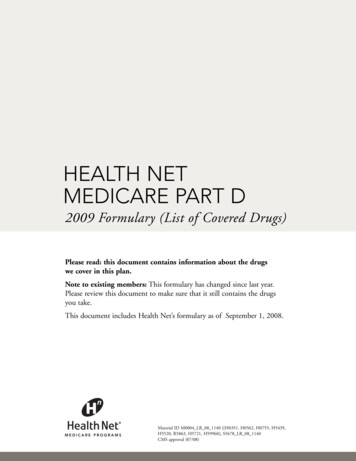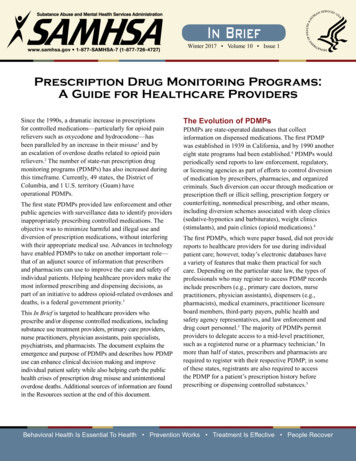
Transcription
In BriefWinter 2017 Volume 10 Issue 1Prescription Drug Monitoring Programs:A Guide for Healthcare ProvidersSince the 1990s, a dramatic increase in prescriptionsfor controlled medications—particularly for opioid painrelievers such as oxycodone and hydrocodone—hasbeen paralleled by an increase in their misuse1 and byan escalation of overdose deaths related to opioid painrelievers.2 The number of state-run prescription drugmonitoring programs (PDMPs) has also increased duringthis timeframe. Currently, 49 states, the District ofColumbia, and 1 U.S. territory (Guam) haveoperational PDMPs.The first state PDMPs provided law enforcement and otherpublic agencies with surveillance data to identify providersinappropriately prescribing controlled medications. Theobjective was to minimize harmful and illegal use anddiversion of prescription medications, without interferingwith their appropriate medical use. Advances in technologyhave enabled PDMPs to take on another important role—that of an adjunct source of information that prescribersand pharmacists can use to improve the care and safety ofindividual patients. Helping healthcare providers make themost informed prescribing and dispensing decisions, aspart of an initiative to address opioid-related overdoses anddeaths, is a federal government priority.3This In Brief is targeted to healthcare providers whoprescribe and/or dispense controlled medications, includingsubstance use treatment providers, primary care providers,nurse practitioners, physician assistants, pain specialists,psychiatrists, and pharmacists. The document explains theemergence and purpose of PDMPs and describes how PDMPuse can enhance clinical decision making and improveindividual patient safety while also helping curb the publichealth crises of prescription drug misuse and unintentionaloverdose deaths. Additional sources of information are foundin the Resources section at the end of this document.The Evolution of PDMPsPDMPs are state-operated databases that collectinformation on dispensed medications. The first PDMPwas established in 1939 in California, and by 1990 anothereight state programs had been established.4 PDMPs wouldperiodically send reports to law enforcement, regulatory,or licensing agencies as part of efforts to control diversionof medication by prescribers, pharmacies, and organizedcriminals. Such diversion can occur through medication orprescription theft or illicit selling, prescription forgery orcounterfeiting, nonmedical prescribing, and other means,including diversion schemes associated with sleep clinics(sedative-hypnotics and barbiturates), weight clinics(stimulants), and pain clinics (opioid medications).4The first PDMPs, which were paper based, did not providereports to healthcare providers for use during individualpatient care; however, today’s electronic databases havea variety of features that make them practical for suchcare. Depending on the particular state law, the types ofprofessionals who may register to access PDMP recordsinclude prescribers (e.g., primary care doctors, nursepractitioners, physician assistants), dispensers (e.g.,pharmacists), medical examiners, practitioner licensureboard members, third-party payers, public health andsafety agency representatives, and law enforcement anddrug court personnel.5 The majority of PDMPs permitproviders to delegate access to a mid-level practitioner,such as a registered nurse or a pharmacy technician.5 Inmore than half of states, prescribers and pharmacists arerequired to register with their respective PDMP; in someof these states, registrants are also required to accessthe PDMP for a patient’s prescription history beforeprescribing or dispensing controlled substances.5Behavioral Health Is Essential To Health Prevention Works Treatment Is Effective People Recover
In BriefThe Nation’s Prescription Drug ProblemMisuse A 2015 survey indicated that an estimated 3.8 millionpeople had used prescription pain relievers in the pastmonth for nonmedical purposes.6 In 2010, there were 33,701 reported admissionsto substance use treatment facilities for combinedbenzodiazepine and opioid pain reliever use, anincrease of 569.7 percent from the 5,032 admissions inthe year 2000.7 The number of people who reported receiving treatmentfor the nonmedical use of prescription pain relievershas more than doubled since 2002, reaching 822,000 in2015.8Emergency Department Visits From 2004 to 2011, the rate of emergency departmentvisits involving misuse of all classes of pharmaceuticalsincreased 114 percent. More than 1.4 million such visitswere made in 2011.9 Over the same 2004–2011 period, the rate ofemergency department visits involving opioid painrelievers increased 153 percent and involved more than420,000 visits.9Deaths From 1999 to 2014, the rate of drug poisoning deathsinvolving opioid analgesics (powerful prescriptionpain relievers) more than quadrupled, with 18,893 suchdeaths in 2014.10 Since 2000, the United States has experienced a200 percent increase in the rate of overdose deathsinvolving opioids (opioid pain relievers and heroin).11 In 2014, drug overdose involving some type of opioidtook the lives of 28,647 people; prescription opioidswere involved in at least half of these deaths.11,12 Methadone prescribed for pain puts users at particularlyhigh risk for overdose death. Methadone is involvedin about one-third of deaths related to opioid painrelievers, even though only 2 percent of pain relieverprescriptions are for this medication.13 (Methadoneused in medication-assisted treatment is not consideredpart of the escalating problem of prescription drugmisuse; nationwide, only a small percentage of opioidrelated deaths involve patients receiving treatment inopioid treatment programs [OTPs]).14Overview of Current PDMPsPDMP databases in most states are housed within alicensing or public health agency; in a few states, they arelocated within a law enforcement agency. Most states trackprescriptions for Schedule II–V controlled medications,and some also track unscheduled medications with misusepotential (e.g., ephedrine, which can be used in themanufacture of methamphetamine). PDMP funding variesby state but includes federal, state, or private sourcesand revenue generated through licensing fees or othermechanisms.4Most PDMPs update their data on a daily or weekly basis,enabling prescribers and dispensers to assess a patient’srecent patterns of use or misuse. Systems are evolvingtoward even more frequent updating; in 2012, Oklahomabecame the first state to institute real-time reporting,with prescription data available within 5 minutes aftermedication is dispensed.15 Real-time reporting can offersome advantages; in particular, emergency departmentcare providers can find near real-time prescription historiesfor patients presenting for acute care.Some state PDMPs provide batch reporting; this is a utilitythat enables prescribers to obtain summary histories for agroup of patients, such as those scheduled for upcomingappointments. The practitioner can review the summariesto determine whether a full report should be ordered forany particular patient.4A majority of state PDMPs are authorized to sendunsolicited reports to providers, licensing boards, or lawenforcement agencies when a prescriber’s or prescriptionrecipient’s activity exceeds thresholds established bythe PDMP.5,16 Unsolicited reports can alert healthcareproviders to intervene with patients whose prescriptionrelated behavior may suggest substance misuse, whereasunsolicited reports to investigative agencies or licensureboards can support investigations into potential drugdiversion or problematic prescribing.16More than half of the states5 are building out systems toallow for data sharing across systems, agencies, and states.Benefits of this system integration include the following:providers can obtain patient prescription history withinthe electronic health record system instead of logginginto two separate systems; state Medicaid agencies can2Behavioral Health Is Essential To Health Prevention Works Treatment Is Effective People Recover
Prescription Drug Monitoring Programs: A Guide for Healthcare ProvidersWinter 2017, Volume 10, Issue 1share information with federal health service providers(e.g., U.S. Department of Veterans Affairs, Indian HealthService); and adjacent states are able to share informationto address illicit cross-border prescription filling or toprovide for better coordination of the care that a patient isreceiving in different states.How PDMP Data Are CollectedPharmacies must submit required data to their state’sPDMP for each prescription they dispense for specifiedcontrolled substances. Pharmacies in the U.S. Departmentof Veterans Affairs and in the Indian Health Serviceare also authorized to submit data to PDMPs, and suchpharmacies in many states do so.17,18 Depending on astate’s legislative requirements, the following entities/individuals may also be required to submit prescriptiondata when dispensing controlled substances: emergencydepartments, wholesale distributors, licensed hospitalpharmacies, physicians, veterinarians, dentists, andmedical and behavioral health service providers.Information collected typically includes date dispensed,patient, prescriber, pharmacy, medication, and quantity.This information is submitted to databases in electronicform. The intervals at which pharmacies are required tosubmit data vary by state.How Prescribers and Pharmacists UsePDMP DataPDMP reports can be used by a healthcare practitionerwith other support tools (e.g., documentation templates,patient data reports and summaries, computerizedPrivacy and SecurityEnsuring the privacy and security of health informationis critical for several reasons, including preventionof identity theft and medical fraud. One example ofa safeguard is that many PDMPs are prohibited fromproviding identifying information about individualpatients or practitioners in reports to law enforcementagencies, except in specified situations such as in responseto a subpoena or for an active case investigation.4,19 Suchprohibitions are also intended to protect confidentialityand avoid potential targeting of providers engaged inlegitimate prescribing and dispensing activities.alerts and reminders) when screening a new patient ormonitoring a current patient. The practitioner can reviewthe patient’s prescription record from the PDMP to confirmor augment information provided by the patient’s ownreports and the medical exam. Providers can promotepatients’ acceptance of this tool by proactively informingthem that PDMP data are routinely checked for all patientsto enhance care and that confidentiality and privacy areprotected by law and regulation.For example, when treating for chronic pain, a practitionercan check the state PDMP for data on the patient’s historyof prescriptions for controlled substances. This informationcan be used to determine whether the patient is alreadyreceiving opioid medications or other medications that,when combined with an opioid prescription, might put himor her at risk for overdose. The Centers for Disease Controland Prevention (CDC) advises: “Clinicians should reviewPDMP data when starting opioid therapy for chronic painand periodically during opioid therapy for chronic pain,ranging from every prescription to every 3 months.”20Whether updated in real time or at some other regularinterval, a PDMP provides longitudinal information fromwhich a healthcare practitioner can identify patterns ofinappropriate prescription medication use or risky substanceuse behavior. PDMP data may suggest that a patient has anuneventful prescription history, giving confidence to thepractitioner that the patient has a legitimate need for anyscheduled prescription medications under consideration. Thedata can also reveal whether the patient has been prescribedmedication that may create a risk for interaction withmedication the practitioner is considering prescribing. Forexample, the data can suggest the total level of morphineequivalent to which a patient already has access and whetherthe patient has access to other medication(s) that may, incombination, put the patient at risk for overdose. Anotherpotential use of the data is to determine whether a patienthas failed to fill a prescription for medication previouslyprescribed by that practitioner; in such situations, thepractitioner can initiate a conversation about why the patientis not taking the medication as indicated.A practitioner can also use PDMP data to monitor patientswith suspected or known substance use disorders bychecking patient records for medically unwarrantedconcurrent use of prescription medication (e.g., high doses3Behavioral Health Is Essential To Health Prevention Works Treatment Is Effective People Recover
In BriefExceptions to PDMP Data ReportingRequirementsTypically, prescriptions for intravenous medications andthose filled by hospice palliative care are not submittedto PDMPs. In addition, federal confidentiality rules(42 CFR Part 2, Confidentiality of Alcohol and DrugAbuse Patient Records) exempt medications dispensed atOTPs—that is, when a medication for the treatment of asubstance use disorder (e.g., methadone, buprenorphine)is dispensed at an OTP, patient-identifying information isnot submitted to the PDMP. There are some exceptionsspecified in the federal regulations. OTP-based prescribersmay access PDMP information to help manage the careof their patients, and the Substance Abuse and MentalHealth Services Administration (SAMHSA) encouragesthem to do so.21 It is especially important that OTP-basedphysicians and physicians who are qualified to prescribebuprenorphine for opioid use disorder (i.e., physicians whohave received a waiver under the Drug Addiction TreatmentAct of 2000) access the PDMP, because these physiciansare the only practitioners who have full knowledge of theirpatients’ controlled medication histories.of several prescriptions, including long- and short-actingopioids as well as benzodiazepines) and use of multipleprescribers or pharmacies. Other indicators of potentiallyproblematic prescription use that a practitioner can lookfor when reviewing PDMP data include early refills anddose escalation.Behavior that suggests substance misuse, a substance usedisorder, or diversion is known as aberrant drug-relatedbehavior.* PDMP data can alert a practitioner to aberrantbehavior such as doctor shopping (obtaining overlappingprescriptions from different doctors for intendednonmedical use) or pharmacy shopping (visiting multiplepharmacies to fill prescriptions); these are called “multipleprovider episodes.”PDMP data are best used in conjunction with other sourcesof information, including clinical assessment, beforemaking any determinations about aberrant behavior,22because no validated and standardized criteria for thethreshold of questionable activity have been established.4A patient who has obtained prescriptions from multipleproviders is not necessarily a “doctor shopper”; thepatient could have legitimately received prescriptionsfrom different specialists for diverse conditions (e.g., aterminal disease or disorder, chronic pain, postsurgicalpain). There are also plausible reasons why a patientmight fill prescriptions at multiple pharmacies (e.g.,because different pharmacies may be closer to work orhome, because a particular pharmacy offered a coupon).For these reasons, a proposed operational definitionof shopping behavior for medications at high risk formisuse or diversion is having “overlapping prescriptionswritten by different prescribers and filled at three or morepharmacies” (emphasis added).23When PDMP data, combined with other information,indicate that a patient may be engaging in aberrantbehavior, the practitioner can use this information in themedical setting with the patient as a basis for an immediateconversation or intervention. To ensure that the patientdoes not misuse prescribed medication, the practitioner canmonitor PDMP data in conjunction with urine drug testingand use of a treatment agreement (a contract betweenpatient and practitioner on what each of them will do).Before prescribing an opioid for pain, the practitioner canassess PDMP data to ensure that a patient is not obtaining,through other prescribers, medication with sedativeeffects (e.g., other opioids, benzodiazepines), which couldheighten risk of overdose when used simultaneously withthe opioid. PDMPs provide another valuable functionin that providers can use them to periodically reviewtheir own prescribing record, to confirm that their DrugEnforcement Administration (DEA)-controlled substancenumber has not been used illegally by another person.4,24Not only prescribers but also pharmacists are enhancingpatient care through their use of PDMPs. For example,pharmacists can identify interaction risks from multipleprescriptions. Pharmacists can also initiate conversationswith patients whose prescription use patterns indicatepossible substance misuse, and they can refer suchpatients for screening and counseling and link them withinformational resources on substance use disorders and*Treatment Improvement Protocol (TIP) 54, Managing Chronic Pain in Adults With or in Recovery From Substance Use Disorders, provides adescription of aberrant drug-related behaviors on pages 54 and 56.4Behavioral Health Is Essential To Health Prevention Works Treatment Is Effective People Recover
Prescription Drug Monitoring Programs: A Guide for Healthcare ProvidersWinter 2017, Volume 10, Issue 1substance use disorder treatment. Alternatively, theycan contact the patient’s prescriber, who may be bestpositioned to provide resources or referrals. Pharmacistscan also use PDMP data to flag suspicious prescribingpatterns that may indicate aberrant, illicit, or unsafeprescribing by medical professionals.PDMP EffectivenessProvider surveys, case studies, state evaluations, andother reports offer growing evidence that individual statedatabases are reducing diversion while also improvingindividual clinical decision making and prescribingpractices and lowering rates of admissions for substanceuse treatment.25 For example, after New York and Tennesseerequired prescribers to consult their state’s database beforeprescribing pain medications, the percentage of patients withmultiple provider episodes (receiving prescriptions from fiveor more prescribers or filling prescriptions at five or morepharmacies in a 3-month period) dropped 75 percent and36 percent, respectively.26Evidence from states with mandates also suggests thatPDMP utilization supports appropriate prescribing anddispensing. In the 1-year period beginning 2 months afterKentucky’s mandate on enrollment and use of its PDMPwent into effect (in July 2012), overall dispensing ofcontrolled substances in the state declined 8.5 percent.In approximately the same period, prescriptions forbuprenorphine (a medication used in treatment of opioiduse disorder) increased nearly 90 percent. According tothe PDMP Center for Excellence, these two data pointsindicate that the PDMP mandate suppresses inappropriateprescribing but does not impinge on legitimate prescribing.26PDMP utilization may also be a factor in reducingmortality associated with opioid use. A 2016 study of34 states (32 with PDMPs) found that the rate of opioidrelated deaths declined in states in the year after PDMPimplementation. States whose PDMPs had more robustfeatures (e.g., more frequently updated data) experiencedgreater reductions in deaths compared with states whosePDMPs did not have those features.27Ohio’s experience indicates that PDMPs can be asignificant tool in a broader program to encourage andenforce safe prescribing practices. In 2011, the stateadopted rules that mandate prescriber and dispenseruse of the PDMP under certain conditions. At the sametime, the state instituted other measures designed to curbmisuse of prescription drugs, including crackdowns onpill mills (physicians, clinics, or pharmacies that prescribeor dispense controlled medications inappropriately orfor nonmedical reasons), licensing restrictions on painmanagement clinics to prevent overprescription of opioidpain medications, and the institution of a drug take-backprogram. In the first quarter of 2014 alone, the PDMPreceived requests for 2 million reports.26A concern that has been raised about PDMPs is that theycould suppress the availability of opioid medication forlegitimate cases of pain. A 2016 study found that across24 states implementing PDMPs, a sustained 30 percentreduction in the rate of prescribing Schedule II opioidsoccurred; however, there was no significant impact on theoverall prescribing of pain medication (the study did notevaluate whether patients’ pain was effectively managed).28One small study (N 179) of patients presenting withnonacute pain conditions in an emergency departmentfound that in 41 percent of the cases, clinicians alteredtheir prescribing plan after consulting the state’s PDMP;changes went in both directions, with the planned opioidprescribing reduced in 61 percent of the cases andincreased in 39 percent.29Other initial studies indicate that PDMPs do not have asuppressive effect, although they may affect the typesof opioids that are prescribed. A 2009 study found that,between 1997 and 2003, compared with states withoutPDMPs, states with PDMPs had a smaller number ofshipments per capita (from suppliers to distributors suchas pharmacies) for oxycodone (a medication highlyassociated with drug diversion) and reduced admissionsfor the treatment of prescription opioid misuse. At thesame time, overall opioid shipments increased, indicatingno chilling effect on the prescribing of opioids overall.30According to a study on Project Lazarus—a program inWilkes County, NC, that combines PDMP surveillancedata with public health education, prevention, andtreatment efforts—overdose deaths in the county declined69 percent from 2009 to 2011, even though the number ofopioid prescriptions remained nearly level and was higherthan the state average.31 In a pilot study of the IndianaPDMP in 2012, physicians reported that the clinical care5Behavioral Health Is Essential To Health Prevention Works Treatment Is Effective People Recover
In Briefthey provided was enhanced by use of PDMPs; dependingon their patients’ clinical needs, physicians both reduced(by 58 percent) and increased (by 7 percent) the number ofprescriptions written or number of pills dispensed.32Another concern is the perception that increasedprescription monitoring through PDMPs may be a factorthat causes people who are dependent on prescriptionopioids to switch to heroin use, contributing to heroinrelated overdose deaths (the rate of heroin-related deathsalmost tripled from 2010 through 201333). However,according to an analysis of 2002–2011 data from theNational Survey on Drug Use and Health, of people whoinitiate nonmedical use of pain relievers, only 3.6 percenttransition to heroin use within 5 years of initiation.34According to the report Trends in Heroin Use in the UnitedStates: 2002 to 2013, “The concern that efforts to preventthe illegal use of prescription opioids are causing peopleto turn to heroin is not supported by the trend data. . . .Although research indicates that people who previouslymisused prescription pain relievers were more likelyto initiate heroin use than people who had not misusedprescription pain relievers, most people who misuseprescription pain relievers do not progress to heroin use.”35Furthermore, according to a 2016 review article,36implementation of most policy decisions aimed at reducingrates of nonmedical use of opioid medications occurredafter heroin use rates had begun trending upward. Theauthors point to heroin’s increased accessibility, reducedprice, and high purity as factors that may have contributedto increases in the drug’s use. In addition, the reviewhighlighted studies of Florida and Staten Island, NY, thatfound that policy-induced reductions in the rates of opioidprescribing were associated with reductions in overallopioid-related deaths (that is, deaths related to eitherheroin or opioid medication use). Based on the overallfindings of the review, the authors recommended enhanceduse of PDMPs as part of a comprehensive strategy toreduce initiation of nonmedical opioid use.PDMPs as a Public HealthSurveillance ToolProjects are in development to enhance use of statePDMPs for public health surveillance. Several stateshave provided PDMP information (typically with patient-and prescriber-specific identification details hidden orremoved) to researchers for the purpose of identifyingtrends in prescribing patterns.4 This type of aggregateinformation can be combined with health outcomesdata—such as those compiled by emergency departments,medical examiners, poison control centers, and substanceuse treatment centers—to provide community-level riskdata for use in planning community-level interventions.22Several federal agencies have coordinated with thePDMP Center of Excellence to establish the PrescriptionBehavior Surveillance System (PBSS). This is an earlywarning surveillance and evaluation tool that can analyzede-identified, population-based, longitudinal data frommultiple states.37 PBSS data are being used to measuretrends in controlled substance prescribing and to supporteducational initiatives for safe and appropriate prescribing.For example, one PBSS-based report, published in 2015,analyzed data from eight states representing one-fourthof the U.S. population.38 Among other trends, the analysisrevealed the common practice of coprescribing opioidsand benzodiazepines. This happens despite the fact thatpatients who concurrently use both types of medicationface increased risk for potentially fatal overdose.2How Prescribers and PharmacistsCan Access PDMPsA healthcare provider must enroll in a PDMP to becomean authorized user before obtaining access to its data.Typically, the enrollment procedure involves certifyingcredentials, authenticating providers through properidentification, and establishing secure system accessthrough passwords and/or biomarkers. These proceduresare intended to restrict entry to users with legitimatepurposes for accessing the data. Several states havedeveloped streamlined registration systems that makeenrollment easier, while still maintaining confidentialityand security.4Related Recommendations forHealthcare ProvidersPDMP use complements other measures that providerscan take to prevent misuse and diversion of prescriptionmedications and to help ensure the safety of patients usingthem. Some of these measures are described below.6Behavioral Health Is Essential To Health Prevention Works Treatment Is Effective People Recover
Prescription Drug Monitoring Programs: A Guide for Healthcare ProvidersWinter 2017, Volume 10, Issue 1Increase knowledge about substance use disordersand their prevention and treatment. Many prescribershave had little or no education on substance use disorderissues, either in professional school or through recurrenttraining.39,40 Furthermore, many prescribers are noteducated or trained in prescribing practices that minimizerisk with commonly misused medications.39,41 Less thanhalf of the states have statutes or regulations that require orrecommend education for prescribers of prescription painmedication.42 SAMHSA and other sources offer onlinelearning opportunities on substance use disorders andrelated topics (see “Continuing education opportunities” inthe Resources section of this document).Increase knowledge about safe opioid prescribing.According to the Food and Drug Administration (FDA),43obtaining training on opioid pharmacotherapy is oneof three key actions prescribers can take to help curbthe opioid public health crisis in the United States. Theother two are reviewing and knowing the most currentopioid drug labels and helping educate patients on usingprescription opioids safely and effectively. Valuableinformation on this topic is available from CDC andother sources (see “Opioid prescribing resources” and“Continuing education opportunities”).Write prescriptions for controlled substanceselectronically. Electronic Prescriptions for ControlledSubstances, a DEA initiative, permits electronicprescribing so long as both the prescriber and the dispenseruse secure electronic health IT that meets DEA criteria.44Objectives of all electronic prescribing are to reduceopportunities for fraudulent prescriptions and betteridentify cases of misuse, improve efficiency and streamlineprescriber workflow, inform clinical decision making, andimprove patient safety by reducing adverse events. (See“Opioid prescribing resources.”)Become informed about risk-reduction strategies foropioid overdose. Providers can incorporate overdoseprevention messages in their communications with patientswho have prescriptions for controlled medication andwith these patients’ caregivers. These messages can coveropioid risk and safety, potential side effects, signs ofoverdose, rescue breathing techniques, administration ofnaloxone (see next paragraph), and guidance on when tocall 911. Providers can also consider developing a programpolicy for responding to onsite overdose.Become informed about the use of naloxone fortreatment of opioid overdose. Available by prescription,naloxone is an opioid antagonist that is used to counter theeffects of opioid overdose. The medication successfullyreversed more than 26,000 overdoses between 1996 and2014.45 Wider distribution of naloxone, and more training inits use, could save many lives.46 The product is available inauto-injector and nasal spray formulations, which facilitateimmediate administration by laypeople on the scene ofan overdose, before emergency response professionalsarrive.47 U.S. Department of Health and Human Servicesagencies, including SAMHSA, are working to expanddistribution of naloxone t
Prescription Drug Monitoring Programs: A Guide for Healthcare Providers Winter 2017, Volume 10, Issue 1 share information with federal health service providers (e.g., U.S. Department of Veterans Afairs, Indian Health Service); and adjacent states are able to share information to address illici
